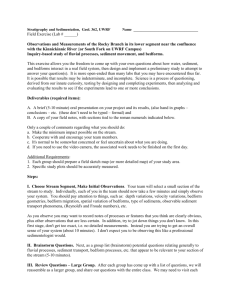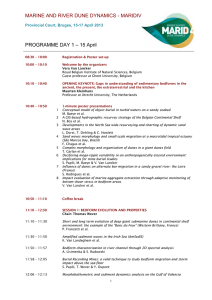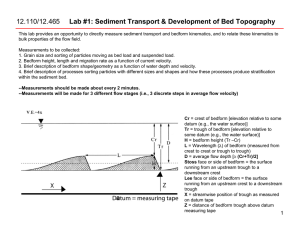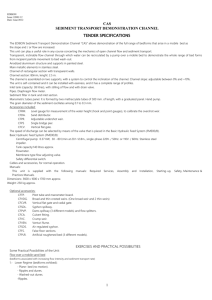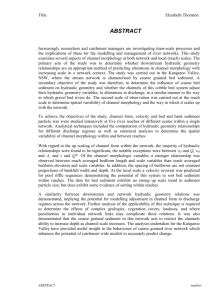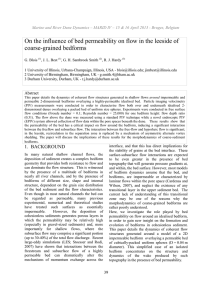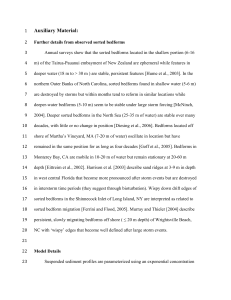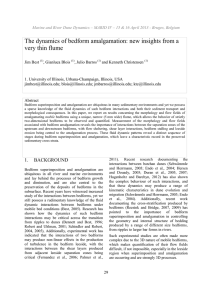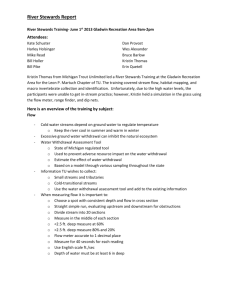Stratigraphy and Sedimentation, Geol
advertisement
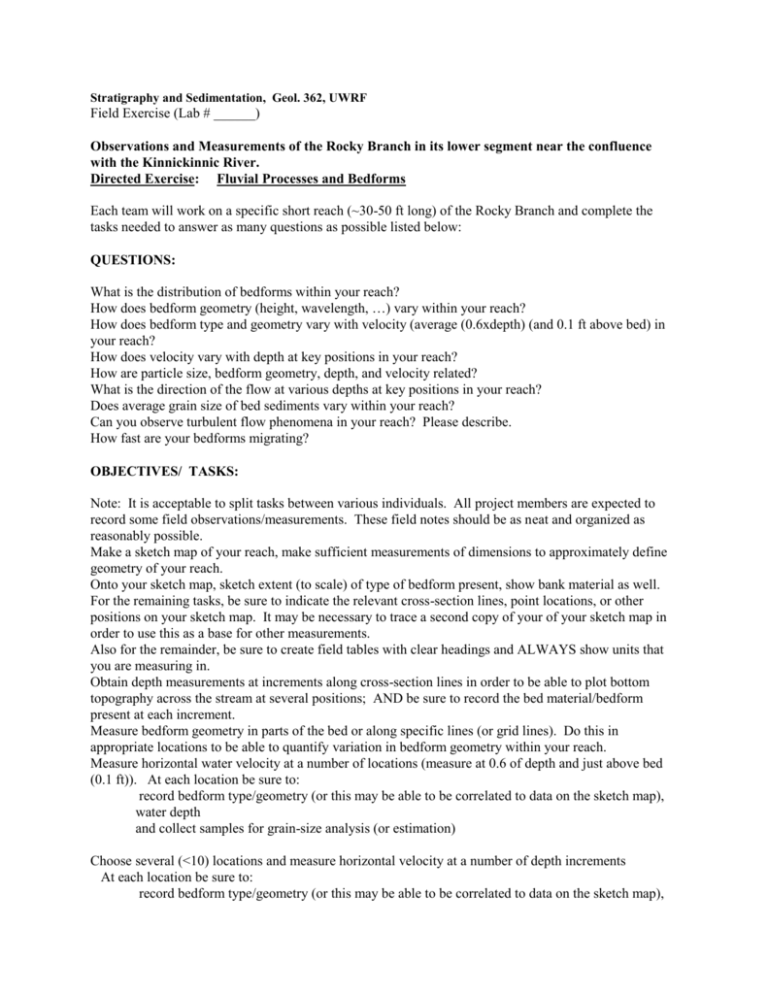
Stratigraphy and Sedimentation, Geol. 362, UWRF Field Exercise (Lab # ______) Observations and Measurements of the Rocky Branch in its lower segment near the confluence with the Kinnickinnic River. Directed Exercise: Fluvial Processes and Bedforms Each team will work on a specific short reach (~30-50 ft long) of the Rocky Branch and complete the tasks needed to answer as many questions as possible listed below: QUESTIONS: What is the distribution of bedforms within your reach? How does bedform geometry (height, wavelength, …) vary within your reach? How does bedform type and geometry vary with velocity (average (0.6xdepth) (and 0.1 ft above bed) in your reach? How does velocity vary with depth at key positions in your reach? How are particle size, bedform geometry, depth, and velocity related? What is the direction of the flow at various depths at key positions in your reach? Does average grain size of bed sediments vary within your reach? Can you observe turbulent flow phenomena in your reach? Please describe. How fast are your bedforms migrating? OBJECTIVES/ TASKS: Note: It is acceptable to split tasks between various individuals. All project members are expected to record some field observations/measurements. These field notes should be as neat and organized as reasonably possible. Make a sketch map of your reach, make sufficient measurements of dimensions to approximately define geometry of your reach. Onto your sketch map, sketch extent (to scale) of type of bedform present, show bank material as well. For the remaining tasks, be sure to indicate the relevant cross-section lines, point locations, or other positions on your sketch map. It may be necessary to trace a second copy of your of your sketch map in order to use this as a base for other measurements. Also for the remainder, be sure to create field tables with clear headings and ALWAYS show units that you are measuring in. Obtain depth measurements at increments along cross-section lines in order to be able to plot bottom topography across the stream at several positions; AND be sure to record the bed material/bedform present at each increment. Measure bedform geometry in parts of the bed or along specific lines (or grid lines). Do this in appropriate locations to be able to quantify variation in bedform geometry within your reach. Measure horizontal water velocity at a number of locations (measure at 0.6 of depth and just above bed (0.1 ft)). At each location be sure to: record bedform type/geometry (or this may be able to be correlated to data on the sketch map), water depth and collect samples for grain-size analysis (or estimation) Choose several (<10) locations and measure horizontal velocity at a number of depth increments At each location be sure to: record bedform type/geometry (or this may be able to be correlated to data on the sketch map), water depth and collect samples for grain-size analysis (or estimation) Use the flow vector sticks to help visualize flow at certain locations within your reach, use these in locations scattered about your reach, or focus in on specific bedforms to attempt to visualize flow around individual bedforms. Create a standard method for recording and documenting these measurements. One way is to draw circles Map to indicate the position 5 15 of the threads, and then use lines radiating from 25-140 the circle to indicate flow direction at specific heights above the bed, which you record by labeling the appropriate line with the height above bed this direction was determined Collect sufficient samples to determine or visually estimate the grain-size distribution in your reach. Use the flow vector sticks, and possibly some dye (food coloring), to attempt to visualize details of the flow, and its turbulent character. Also watch the behavior of grains on the bed, and then describe how turbulence effects flow on and near bedforms. Obtain measurements to determine bedform migration rate at representative areas in your reach. Two ways to do this are: Use Video camera held in constant position with sufficient “in-stream” markers of distances, with later measurement off the VCR, or Place numerous stakes in bedform at known start time and then allow time to elapse and then nd place 2 set of stakes along same bedform after it has moved downstream. Measure distances from stakes along transport paths, use recorded time to calculate bedform migration rate. This exercise involves completing as many of the tasks that you can in the field time available. Good clear field notes are imperative!! I will need your field notes turned in as an Appendix to your report. If you really feel like you’d like to finish a couple more of the tasks, you may do this on your own time. You will need to create your own field tables, be sure to make these clear, and ALWAYS list units you are measuring in. Later you will need to analyze your field measurements and prepare tables, charts, diagrams, as appropriate to explain the relationship between fluvial processes and bedforms in your stream reach. Deliverables (required items): A. A formal written final report (you may do this jointly as a team or hand in individual reports), B. A draft report, with peer editing marks shown. C. A brief (5-10 minute) group oral presentation on your project and its results, and D. A copy of your field notes attached as an Appendix to the final report. A few additional comments regarding this project. a. Make the minimum impact possible on the stream. b. Cooperate with and encourage your team members. c. It's normal to be somewhat uncertain about what you are doing. Ask questions/work together to resolve. d. We have limited instruments for measuring current velocity. When your group has a current meter, please take the measurements you will need, in order to free the meter up for other group use. e. Similarly, if you plan to use the video camera, it may need to be shared with other groups. X. Submit the draft summary report to one or more fellow classmates (from another group), for their review and edits. They will review your report within 3 days, sign their name as reviewer on the front cover sheet, and will indicate when they received the report. XI. Obtain 2 overheads from me for preparation of your brief oral summary on your project. XII. Present a brief oral summary of your project. XIII. Keep the draft summary report with the peer editors' marks on it, and then turn this in along with your final edited version of the report; also remember to turn in your original field notes (or copies). If you compile one group report, include each member's field notes in the appendix. XIV. Smile and take a deep breath, you deserve it! Materials: Buckets: Dowels Thread, Glue Rope String Measuring tape Shovel Clear Plastic Rectangular Pan Current meters Video camera Camera Polarizer Flags Straws Pipes Brunton Surveying Equipment Surveying Rods Meter Sticks Plastic rulers Ziploc bags Markers Thin clear PVC pipe with stoppers colored sand hammer, mallet duct tape electrical tape small plastic boxes? bottles hand lens.
